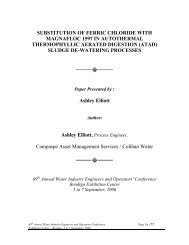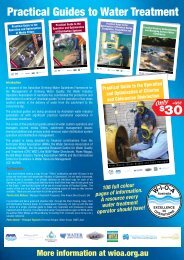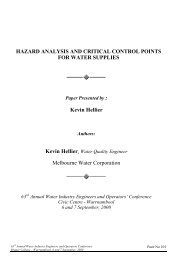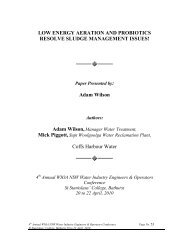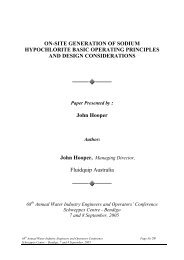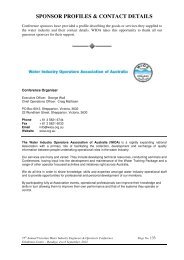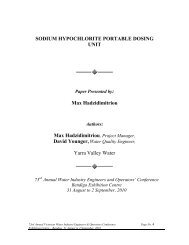CHLORINE GAS V's SODIUM HYPOCHLORITE - WIOA
CHLORINE GAS V's SODIUM HYPOCHLORITE - WIOA
CHLORINE GAS V's SODIUM HYPOCHLORITE - WIOA
Create successful ePaper yourself
Turn your PDF publications into a flip-book with our unique Google optimized e-Paper software.
3.0 HEALTH CONSIDERATIONSWater Quality guidelines are becoming more stringent resulting in increased treatmentand monitoring chemical. Additional to treatment costs is the enormous cost associatedwith public liability in the event of an incident involving public health (egcryptosporidium). Chlorine gas can continually deliver the required level of disinfectionwhen applied correctly, however there are serious doubts with regard to the use ofsodium hypochlorite for disinfection of both potable water and waste water. These doubtshave arisen for two reasons:1. The degradation of sodium hypochlorite is virtually instantaneous. The resultantby-product, sodium chlorate, is dangerous to public health when it reaches definedlevels. Consequently, countries such as USA have introduced water qualityguidelines that prescribe the maximum allowable limit of chlorates in potablewater. These limits may soon be implemented in the Australian Water Qualityguidelines. These guidelines can be met if the sodium hypochlorite is used soonafter manufacture, however, for any Water Company storing sodium hypochloriteon site, it is strongly recommended that they implement chlorate testing before thesodium hypochlorite is used to ensure that they do not breach the new guidelines.As the degradation process is strongly influenced by time and temperature, thestorage time allowable for sodium hypochlorite will vary according to thecustomer’s storage conditions.2. The degradation of sodium hypochlorite also affects the strength of the product.Orica manufactures hypo each night for distribution the next day. Manufacturestrength is typically 14 - 15% which ensures that the product is still at a minimumof 13% chlorine when it reaches our customers. However, depending upontemperature, storage conditions and storage time, the sodium hypochlorite willcontinue to lose strength. For customers storing hypo on site, this may result inunder chlorination of the water supply due to the consequent loss in strength. Formany companies this may create a situation equivalent to a period of nondisinfectionand a serious health concern.4.0 ENVIRONMENTAL CONSIDERATIONSWhen considering the environmental risks of chlorine most people think of the dangersassociated with the release of a chlorine cloud to the atmosphere. In reality a purechlorine gas cloud will disperse very quickly and, according to the Chlorine Institute, isunlikely to reach/affect the Ozone layer. However, if chlorine is released in largequantities to the waterways, it’s strong oxidising properties will cause it to form byproductswhich are detrimental to marine plant and animal life. The likelihood of anaccidental release of chlorine gas into the waterways is negligible, however, there is anincreasing frequency of accidental releases of sodium hypochlorite into these sensitiveenvironments. The most common causes of such leaks are transport accidents and tankruptures.The likelihood of a transport or storage incident increases with the number of deliveriesand quantities stored. A single deliver of 6 x 920kg drums of chlorine gas would requirethe equivalent of 6 separate deliveries of 9,200L of sodium hypochlorite. Therefore, thenumber of transport and storage related incidents with sodium hypochlorite are higher.67 th Annual Water Industry Engineers and Operators ConferenceSports and Leisure Centre – Wodonga, 1 and 2 September, 2004Page No 13



